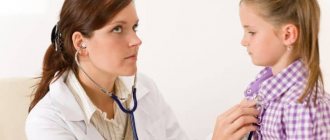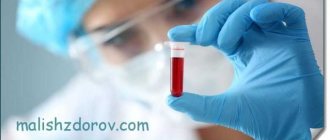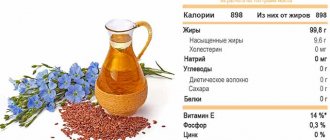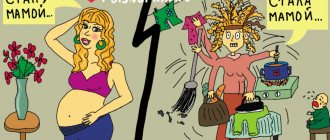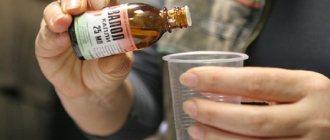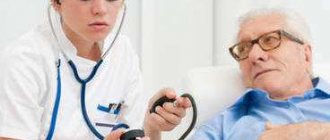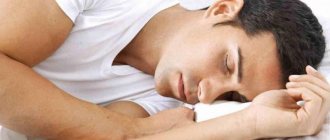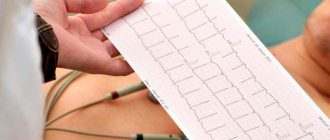According to doctors, rapid heartbeat in a child, or scientifically tachycardia, can occur due to many reasons: from the presence of a cold in the body to being in a hot room. In some cases, this does not pose a threat to the health of the little person. But if attacks of tachycardia are repeated, over and over again, or occur when the child is not busy with anything, is emotionally calm and is in a lying or sitting position, you should under no circumstances hesitate and immediately, if even one symptom appears, contact a cardiologist for help and undergo examinations.
Heart rate: norms in pediatric practice
The peculiarities of the development of the cardiovascular system in children and adolescents are such that the normal parameters largely depend on age. Each stage of a child’s life has its own heart rate.
The heart muscle of a newborn contracts up to 140 times per minute. In adolescence, the parameters are equal to adult standards and should not exceed 90 beats per minute.
You can measure a baby’s heart rate quite simply: just place your palm on the area where the heart is projected and time a minute, while counting the number of heart beats. You can feel the artery in your child's wrist and take the pulse. The heart rate and pulse rates in the peripheral artery in a healthy person are equal.
Today, experts focus on the following age-related normal parameters in pediatric practice:
- from birth to one year – 130–160 beats/min.;
- before reaching two years – up to 150 beats/min.;
- at 2–4 years – 115–135 beats/min.;
- from 4 to 6 years – from 80 to 130 beats/min.;
- at 6–8 years old – 75–130 beats/min.;
- at 8–11 years old – up to 70–110 beats/min.;
- at 11–15 years old – the norm is 70–80 beats/min.
A deviation of parameters by 20–30 indicators—a rapid heartbeat in a baby—indicates the formation of malfunctions in the cardiovascular system. A mandatory diagnostic examination is required in order to clarify the nature of such a negative condition.
Treatment
In most cases, the heart rate accelerates with excitement, physical activity and hormonal changes in adolescence. If there is no organic pathology, then you need to calm down - this is often enough to normalize the condition. According to indications, the child is prescribed medications, or he is sent to a surgical hospital for surgery.
Drug therapy
Organic pathology is considered the main indication for prescribing medications. Children can be given drugs from the following groups:
- beta-blockers ("Pindolol");
- cardiac glycosides (Digoxin);
- calcium antagonists (“Verapamil”);
If there is no effect from the therapy, if complications arise or the child’s condition worsens, the child is referred for surgery. During pregnancy in girls under 18 years of age, possible contraindications are clarified.
Non-drug therapy
When tachycardia interferes with the quality of life, then, according to the recommendations of Dr. Komarovsky, you need to use therapeutic methods:
- Massage of the carotid sinus in the neck in the area of the carotid artery. It should not be performed for a long time, so as not to lead to an excessive slowdown of the heart rate.
- Short-term straining of the abdominal muscles, lasting 1.5-2 minutes.
- Covering the face with pieces of ice.
- Pressing on the eyeballs while lying down.
If the methods alleviate the condition for a short time or are completely ineffective, then the child is given herbal sedatives. If there are contraindications, they cannot be used. The most popular are motherwort and valerian. In most cases, this is also used for emergency purposes.
When all attempts do not lead to positive dynamics, the patient undergoes surgery. Depending on the disease that causes tachycardia, the child will be treated comprehensively. Before this, medication preparation may be required.
There are several surgical options:
- Radiofrequency ablation of veins (rejection of tissue under the influence of radiation).
- Installation of an artificial pacemaker.
- Replace valves when indicated.
- Heart transplant, depending on the severity of the condition.
After the operation, the child must be under medical supervision. It is necessary to follow a diet excluding harmful foods from the diet, drink more water (1.5-2 liters per day).
Causes
In a child with a rapid heartbeat, an excess of the age-related parameters of the norm is recorded by more than 25–30 units. The reasons may be physiological (anatomical features of the heart in childhood):
- Small volume of cameras.
- Smaller vessel diameter.
At the same time, the blood supply needs of a rapidly growing child's body are constantly increasing. The reaction to all this will be a rapid heartbeat.
Other physiological root causes also include:
- excessive physical activity;
- stressful situations;
- temperature changes.
After eliminating the negative factors, heart activity is restored, and heartbeat parameters return to normal. If the condition persists for a long time and cannot be corrected at home, it is not recommended to delay consultation with a specialist and diagnostic procedures. There is a high risk of severe complications, for example, cardiomyopathy.
In addition to the above-mentioned age-related characteristics of the heart and the physiological root causes of increased heart rate, attacks of rapid heartbeat can occur against the background of various pathologies:
- endocrine disorders;
- after suffering infectious diseases;
- after bleeding;
- hyperactivity of the thyroid gland;
- for anemia, hypotension;
- abnormalities in the development of the cardiovascular system - rapid heartbeat in the fetus;
- side effects of certain subgroups of medications when taken for a long time.
Only a comprehensive examination - instrumental and laboratory - allows a specialist to collect information, assess the current condition and conduct an adequate differential diagnosis.
What to do when treating rapid heartbeat in a child?
In the early stages of a child’s heart palpitations, it is possible to cure the problem without taking any medications, normalizing myocardial activity with the help of soothing herbs - mint, lily of the valley, hawthorn flowers. Also, as a treatment and prevention, the doctor may prescribe drops of valerian or Corvalol several times a day. You should not exceed the course prescribed by the doctor. Let us note that it is important to engage in herbal medicine under the supervision of an experienced cardiologist. Under no circumstances should you do this yourself. Only a doctor knows which herbs and in what dosage are best to drink for certain symptoms. If there are serious problems with the heart, he will prescribe additional medications or procedures.
Types of abnormalities in the activity of the heart
In the practice of pediatricians, two forms of increased heart rate are more common: sinus and paroxysmal.
The sinus form is understood as achieving parameters of more than 100 beats per minute, less often – 180–200. In this case, after a diagnostic examination, the location of the sinus node is revealed in the lateral wall of the atrium. Its excitation is carried out due to parasympathetic as well as sympathetic stimulation. Therefore, when identifying irregularities in the heartbeat, they look for the root cause in this area.
There are three degrees of severity of sinus disorder:
- moderate: with an increase in parameters by 10–20%;
- average: when exceeded by 20–40%;
- if the parameters are exceeded by 40–60%, we are talking about a pronounced disorder.
If the sinus form of the disorder occurs due to physiological reasons, its symptoms will disappear within 5–7 minutes. This does not cause any harm to the baby's health.
In the pathological form of malfunction of the sinus node, clinical manifestations occur frequently, do not stop for a long time, and require appropriate therapeutic measures. Children who have developed a paroxysmal form of heart failure suffer from frequent attacks of increased heart rate up to 150–200 beats per minute. The duration of this state can vary from several seconds to several minutes, less often - up to a day.
In this case, the focus generating high-frequency impulses occurs in the areas of the ventricle or atrium. Based on this, experts distinguish one of two types of pathology:
- ventricular;
- atrial
Both forms require immediate comprehensive treatment. It should only be selected by a specialist. Self-medication is absolutely unacceptable.
Symptoms
In half of the children, attacks appear in the evening and at night, lasting on average about half an hour. The most striking symptoms are accompanied by evening attacks.
- In 60% of children, paroxysmal tachycardia is accompanied by signs of hypertensive-hydrocephalic syndrome, 86% suffer from autonomic dysfunction. Children experience emotional instability, expressed by a sharp reddening of the skin as a result of slight stimulation of the nervous system, wetness of the hands (acrohyperhidrosis), and increased vascular patterns on the skin.
- The attacks are accompanied by bradycardia, difficulty breathing, redness of the skin, sweating, increased sweating, decreased blood pressure, and gastrointestinal upset, which is characteristic of vagotonic type ANS dysfunction. This indicates insufficient work of the sympathetic and increased parasympathetic divisions of the ANS.
- Anxiety and depression and phobias are most common in older children. The child’s psyche is considered traumatized as a result of an unfavorable microsocial environment (incomplete family, parental alcoholism, family conflicts).
In 90% of cases, an attack occurs due to emotional stress, and only in 10% due to physical activity.
Therefore, in addition to autonomic disorders, physical manifestations of paroxysmal tachycardia are observed in the child’s body:
- blood supply deteriorates, as a result, the brain, heart and other organs suffer;
- cervical vessels pulsate;
- the skin becomes pale and sweaty;
- mild cyanosis appears on the lips and mucous membranes;
- sometimes the body temperature rises to subfebrile levels and chills appear;
- large quantities of light-colored urine are excreted.
A child’s behavior during an attack is influenced by age and emotional and personal development. In some children, only parents can notice a short attack of tachycardia, because the child behaves calmly and does his usual activities. Only as a result of a prolonged attack does the child’s condition worsen.
List
beta blockers for tachycardia
will allow you to choose a drug, but you must consult a doctor.
The principles of the diet for tachycardia are described here.
He starts complaining about:
- feeling restless;
- general weakness;
- darkening of the eyes;
- pulsation in temples;
- feeling of “heart jumping out of the chest”;
- dizziness;
- nausea and gag reflex;
- lack of air.
Almost all children suffering from one of the types of tachycardia exhibit the following symptoms:
- attacks of rapid heartbeat, accompanied by strong vibrations of the chest;
- rapid fatigue;
- problems with concentration and attention;
- pain in the chest and under the shoulder blade;
- severe shortness of breath and oxygen deficiency after light exercise;
- attacks of darkening in the eyes;
- development of pre-fainting states.
It is not necessary for a child to exhibit all of these symptoms at once. The appearance of rapid heartbeat and chest pain is enough to contact a cardiologist. You should not delay your visit to the doctor, because... in addition to the reasons listed above, tachycardia may be a symptom of a tumor or other ailment.
Symptoms of the disease.
Enter your pressure
Move the sliders
- interruptions in heart function;
- chest discomfort;
- the appearance of weakness and dizziness;
- strong fear;
- fainting;
- rapid breathing;
- the appearance of shortness of breath;
- pale or bluish skin;
- lethargy;
- increase in liver size;
- swelling of the body.
For the supraventricular form:
- pale skin;
- the appearance of severe sweating;
- frequent urination;
- the appearance of nausea and vomiting;
- protrusion of the neck veins;
- rapid heartbeat;
- popping and loud heart sounds;
- the appearance of lack of air.
Tachycardia in newborns
In newly born infants, the heart rate is already almost twice as high as the norm in adults. Therefore, it can be difficult to diagnose increased heart rate at this age. A deviation from the norm is considered to be the fact if the heart rate exceeds 170 beats per minute and persists for more than 10 seconds.
An abnormal increase in activity in the cardiovascular system is observed in 35–45% of children, which is directly related to increased automatism of the sinus node.
The reasons for this condition may be the following:
- congenital pathologies and anomalies;
- formed due to a number of reasons for anemia;
- state of hypoglycemia;
- acidosis;
- perinatal variant of damage to the structures of the nervous system;
- myocarditis of various natures.
Quite physiological root causes can also be identified:
- swaddling too tight;
- overheating;
- pain impulses of unknown etiology;
- The baby's tendency to worry.
The physiological form is characterized by more arrhythmia of heart contractions, while the pathological disorder is characterized by rhythm rigidity. A rapid heartbeat of over 170 beats per minute for more than two to three days provokes metabolic processes in the myocardium - a life-threatening condition in infants. Such attacks are forcibly stopped by pharmacotherapy in a hospital setting.
What does paroxysmal tachycardia mean?
The doctor’s recommendations depend on the type of tachycardia and the reason that triggered its development. If the illness occurs after the flu or another infection, a course of antibiotics and vitamins is prescribed to finally rid the patient of the pathogen. In case of problems with the functioning of the endocrine system, the patient may be prescribed a course of hormonal medications.
In 86% of cases, tachycardia does not require any drug treatment. It is enough to adjust the work and rest schedule, balance the diet, and introduce physical exercise into daily practice. If a child is exposed to severe emotional stress at school due to the behavior of classmates, he should consult a psychologist or change educational institution.
| Application of vagal tests | Stopping an attack of paroxysmal tachycardia in children can begin with simple methods that are effective for supraventricular and ventricular pathology. With their help, you can reflexively influence the vagus nerve. Apply:
|
| Effect on the central nervous system | Drugs that affect cortical-subcortical relationships are used. For children, therapy can be carried out using:
|
| Relieving palpitations with antiarrhythmic drugs in the event of an attack of supraventricular tachycardia | If vagal methods and effects on the central nervous system do not bring results, it is necessary to reduce the heart rate in a hospital setting using intravenous administration:
|
| Relieving palpitations with antiarrhythmic drugs in the event of an attack of ventricular tachycardia | If a wide QRS complex is observed on the ECG, you must use:
When ECG examination is not possible during therapy, the following is administered intravenously:
|
| Carrying out electropulse therapy | The procedure is carried out in case of ineffectiveness of drug therapy, when an attack of paroxysmal tachycardia persists for a day or more, and there is also a risk of developing heart failure. |
Between attacks, the pathology is treated with antiarrhythmic drugs, for example, Finlepsin in combination with psychotropic and vegetotropic drugs, acupuncture, psychotherapy
The primary diagnostic method is a cardiogram. In this case, specialists must pay attention to the frequency of attacks, the brightness and severity of manifestations.
Tachycardia, as a rule, is a consequence of some problem with the body, so you first need to identify the cause. If the cause is an infectious lesion, treatment will be carried out in this direction. If another pathology is present somewhere, it must be eliminated and the tachycardia will go away on its own.
In most cases, tachycardia is physiological, so no treatment is required. Perhaps some external irritant is considered to be its cause. To eliminate palpitations in such cases, experts advise avoiding the following products:
- coffee and caffeinated products;
- alcoholic drinks, especially beer;
- cigarettes;
- chocolate.
If the cause is a stress factor, it must also be eliminated. To prevent tachycardia in such cases, special mild sedatives may be prescribed. These include valerian or motherwort tincture.
If the problem cannot be eliminated, but specialists have not diagnosed heart failure, treatment with special means is necessary. These include Atenolol or Isoptin. If heart failure is still present, ACE inhibitors, heart glycosides, etc. are added to these drugs.
As for the prevention of tachycardia, it consists of timely treatment of acute or chronic pathologies of the body. For example, if a teenager has problems with blood vessels, there is no point in postponing a visit to a cardiologist. Also factors leading to tachycardia are some diseases of the oral cavity.
Physiological tachycardia in adolescence is a completely normal phenomenon that does not require specific help. But if there is a pathology in the body, and because of it there is an acceleration of the heartbeat, you should not postpone going to a specialist.
How to cure hypertension forever.
In Russia, every year there are from 5 to 10 million calls to emergency medical care for high blood pressure. But Russian heart surgeon Irina Chazova claims that 67% of hypertensive patients do not even suspect that they are sick!
How can you protect yourself and overcome the disease? One of the many recovered patients, Oleg Tabakov, told in his interview how to forget about hypertension forever.
Symptoms
Clinical manifestations of rapid heart activity in children are somewhat different from symptoms in adults. The child feels:
- frequent pain impulses in the head;
- previously uncharacteristic dizziness;
- nausea and vomiting without a history of food poisoning;
- excessive sweating, as well as lethargy;
- discomfort in the projection of the heart;
- sudden loss of consciousness;
- shortness of breath.
The newborn exhibits severe anxiety and increased moodiness against the background of decreased appetite. Parents are advised to be attentive to the baby’s condition, notice any deviations from the norm in a timely manner, and seek advice from a specialist. After all, babies are not able to correctly formulate what worries them.
Diagnostics
Diagnostic measures are based on collecting anamnesis. The specialist asks the child’s parents when their health worsened, how it was expressed, and what measures were taken.
This is followed by a physical examination:
- anthropometry;
- thermometry;
- auscultation and percussion;
- palpation.
If pathological changes in cardiovascular structures are suspected, screening examinations are recommended, namely:
- the frequency and rhythm of heart contractions can be easily observed on the ECG;
- 24-hour ECG monitoring is a safe and informative method;
- ECHO CG is performed to determine the nature of sinus disorder;
- blood tests allow you to determine endocrinological disorders, deviations in the parameters of glucose, hemoglobin, cholesterol;
- EEG allows you to exclude pathologies of brain structures.
Only the completeness of the information received by the specialist from the above diagnostic examinations allows him to conduct an adequate differential diagnosis and identify the true cause of the negative condition in the child.
General characteristics of the pathology
Paroxysmal tachycardia is characterized by a sharp increase in heart rate. In young children the figures reach 200 beats per minute; for older children the numbers are lower - 150-160 beats per minute.
The attack occurs suddenly. Its duration can be several minutes or hours, but rarely lasts more than a day. Indicators normalize as unexpectedly as they increase.
Paroxysmal tachycardia is usually divided into two forms:
- Ventricular. Pathology is caused by organic disorders of the heart muscle. This option is rare in children but is life-threatening.
- Supraventricular. It is also called supraventricular. In this case, the pathology is caused by impaired functioning of the autonomic nervous system, which controls cardiac activity.
First aid
To make their baby feel better during an attack of rapid heartbeat, every parent should know what can be done:
- apply a cloth soaked in cold water to the forehead;
- free the chest from constricting clothing, take the child out into the fresh air;
- if the baby already knows how to fulfill the parents’ requests, ask him to tense his tummy and hold his breath;
- try to calm the baby;
- massage the eyeballs to stop the activity of the vagus nerve;
- If there is no positive effect, immediately contact the emergency medical service.
It is forbidden to give any medications to a child on your own: there is a high risk of side effects that will further aggravate the baby’s condition.
